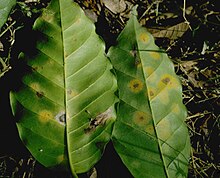Hemileia vastatrix
| Hemileia vastatrix | |
|---|---|
 |
|
| Symptoms of coffee rust caused by Hemileia vastatrix on foliage | |
| Scientific classification | |
| Kingdom: | Fungi |
| Division: | Basidiomycota |
| Class: | Pucciniomycetes |
| Order: | Pucciniales |
| Genus: | Hemileia |
| Species: | H. vastatrix |
| Binomial name | |
|
Hemileia vastatrix Berk. & Broome (1869) |
|
| Synonyms | |
|
Wardia vastatrix J.F.Hennen & M.M.Hennen (2003) |
|
Wardia vastatrix J.F.Hennen & M.M.Hennen (2003)
Hemileia vastatrix is a fungus of the order Pucciniales (previously also known as Uredinales) that causes coffee leaf rust (CLR), a disease that is devastating to susceptible coffee plantations. Coffee serves as the obligate host of coffee rust, that is, the rust must have access to and come into physical contact with coffee (Coffea sp.) in order to survive.
The mycelium with uredinia looks yellow-orange and powdery, and appears on the underside of leaves as points ~0.1 mm in diameter. Young lesions appear as chlorotic or pale yellow spots some millimetres in diameter, the older being a few centimetres in diameter. Hyphae are club-shaped with tips bearing numerous pedicels on which clusters of urediniospores are produced.
Telia are pale yellowish, teliospores often produced in uredinia; teliospores more or less spherical to limoniform, 26–40 × 20–30 µm in diameter, wall hyaline to yellowish, smooth, 1 µm thick, thicker at the apex, pedicel hyaline.
Urediniospores are more or less reniform, 26–40 × 18-28 µm, with hyaline to pale yellowish wall, 1–2 µm thick, strongly warted on the convex side, smooth on the straight or concave side, warts frequently longer (3–7 µm) on spore edges.
Spermogonia and aecia are unknown.
Hemileia lifecycle begins with the germination of uredospores through germ pores in the spore. It mainly attacks the leaves and is only rarely found on young stems and fruit. Appressoria are produced, which in turn produce vesicles, from which entry into the substomatal cavity is gained. Within 24–48 hours, infection is completed. After successful infection, the leaf blade is colonized and sporulation will occur through the stomata. One lesion produces 4–6 spore crops over a 3–5 month period releasing 300–400,000 spores.
While the predominant hypothesis is that H. vastatrix is heteroecious, completing its life cycle on an alternate host plant which has not yet been found, an alternative hypothesis is that H. vastatrix actually represents an early-diverging autoecious rust, in which the teliospores are non-functional and vestigial, and the sexual life cycle is completed by the urediniospores. Hidden meiosis and sexual reproduction (cryptosexuality) has been found within the generally asexual urediniospores. This finding may explain why new physiological races have arisen so often and so quickly in H. vastatrix.
...
Wikipedia
